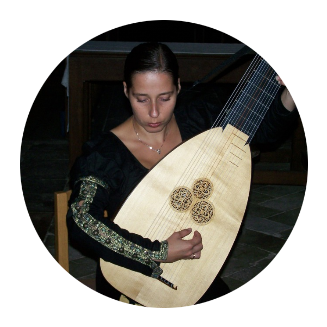Chitarrone
Instruments
A theorbo (Italian: tiorba, also tuorbe; French: théorbe, German: Theorbe) is a plucked string instrument. As a name, theorbo signifies a number of long-necked lutes with second peg-boxes, such as the liuto attiorbato, the French théorbe des pie`ces, the English theorbo, the archlute, the German baroque lute, the angélique or angelica. The etymology of the name tiorba has not yet been explained. It is hypothesized that its origin might have been in the Slavic or Turkish "torba", meaning "bag" or "turban".
Theorboes were developed during the late sixteenth century, inspired by the demand for extended bass range for use in opera developed by the Florentine Camerata and new musical works based on basso continuo, such as Giulio Caccini's two collections, Le nuove musiche (1602 and 1614). Musicians adapted bass lutes (c.80+ cm string length) with a neck extension to accommodate open (i. e. unfretted) bass strings, called diapasons or bourdons. The instrument was called both chitarrone and tiorba. Although theorbo and chitarrone are virtually identical, they have different etymological origins, chitarrone being a descendant of chitarra italiana (hence its name).
Similar adaptations to smaller lutes (c.55+ cm string length) produced the liuto attiorbato and the archlute, also similar-looking but differently tuned instruments.
The tuning of large theorboes is generally characterized by the octave displacement, or reëntrant tuning, of the uppermost of the two (sometimes one) uppermost strings, thus limiting the upper range of the instrument. The courses, unlike those of a Renaissance lute or archlute, were often single, though double-stringing was used too. Typically, theorboes have 14 courses, though a very few pieces from the early Baroque period require a 19-course theorbo.
In the performance of basso continuo, theorboes were often paired with a small pipe organ. The most prominent players and composers of the chitarrone in Italy were Giovanni Girolamo Kapsperger and Alessandro Piccinini. Little solo music for the theorbo survives from England, but William Lawes and others used it in their chamber music, and it also appeared in opera orchestras. In France, theorboes were appreciated and used in orchestral music just as well as in chamber music, until the second half of the 18th century (Nicolas Hotman, Robert de Visée). Court orchestras at Vienna, Bayreuth and Berlin employed theorbo players still after 1750 (Ernst Gottlieb Baron, Francesco Conti).
Solo music for the theorbo is notated in tablature.

